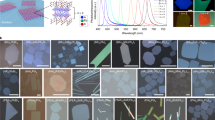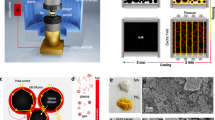Abstract
The ability to create and manipulate materials in two-dimensional (2D) form has repeatedly had transformative impact on science and technology. In parallel with the exfoliation and stacking of intrinsically layered crystals1,2,3,4,5, atomic-scale thin film growth of complex materials has enabled the creation of artificial 2D heterostructures with novel functionality6,7,8,9 and emergent phenomena, as seen in perovskite heterostructures10,11,12. However, separation of these layers from the growth substrate has proved challenging, limiting the manipulation capabilities of these heterostructures with respect to exfoliated materials. Here we present a general method to create freestanding perovskite membranes. The key is the epitaxial growth of water-soluble Sr3Al2O6 on perovskite substrates, followed by in situ growth of films and heterostructures. Millimetre-size single-crystalline membranes are produced by etching the Sr3Al2O6 layer in water, providing the opportunity to transfer them to arbitrary substrates and integrate them with heterostructures of semiconductors and layered compounds13,14.
This is a preview of subscription content, access via your institution
Access options
Subscribe to this journal
Receive 12 print issues and online access
$259.00 per year
only $21.58 per issue
Buy this article
- Purchase on Springer Link
- Instant access to full article PDF
Prices may be subject to local taxes which are calculated during checkout





Similar content being viewed by others
References
Novoselov, K. S. et al. Electric field effect in atomically thin carbon films. Science 306, 666–669 (2004).
Dean, C. R. et al. Hofstadter’s butterfly and the fractal quantum Hall effect in moiré superlattices. Nature 497, 598–602 (2013).
Osada, M. & Sasaki, T. Two-dimensional dielectric nanosheets: novel nanoelectronics from nanocrystal building blocks. Adv. Mater. 24, 210–228 (2012).
Xu, M., Liang, T., Shi, M. & Chen, H. Graphene-like two-dimensional materials. Chem. Rev. 113, 3766–3798 (2013).
Butler, S. Z. et al. Progress, challenges, and opportunities in two-dimensional materials beyond graphene. ACS Nano 7, 2898–2926 (2013).
Wang, Q.-Y. et al. Interface-induced high-temperature superconductivity in single unit-cell FeSe films on SrTiO3 . Chin. Phys. Lett. 29, 037402 (2012).
Chang, C. Z. et al. Experimental observation of the quantum anomalous Hall effect in a magnetic topological insulator. Science 340, 167–170 (2013).
Shishido, H. et al. Tuning the dimensionality of the heavy fermion compound CeIn3 . Science 327, 980–983 (2010).
Bode, M. et al. Chiral magnetic order at surfaces driven by inversion asymmetry. Nature 447, 190–193 (2007).
Caviglia, A. D. Electric field control of the LaAlO3/SrTiO3 interface ground state. Nature 456, 624–627 (2008).
Mannhart, J. & Schlom, D. G. Oxide interfaces-an opportunity for electronics. Science 327, 1607–1611 (2010).
Hwang, H. Y. et al. Emergent phenomena at oxide interfaces. Nat. Mater. 11, 103–113 (2012).
Alferov, Z. I. Semiconductor Heterostructures: Physical Processes and Applications (MIR Publishers, 1989).
Geim, A. K. & Grigorieva, I. V. Van der Waals heterostructures. Nature 499, 419–425 (2013).
Bruel, M. Application of hydrogen ion beams to silicon on insulator material technology. Nucl. Instrum. Methods Phys. Res. Sect. B 108, 313–319 (1996).
Wong, W. S., Sands, T. & Cheung, N. W. Damage-free separation of GaN thin films from sapphire substrates. Appl. Phys. Lett. 72, 599–601 (1998).
Matthews, J. W. Growth of face-centered-cubic metals on sodium chloride substrates. J. Vac. Sci. Technol. 3, 133-145 (1966).
Catlin, A. & Walker, W. P. Mechanical properties of thin single-crystal gold films. J. App. Phys. 31, 2135–2139 (1960).
Rogers, J. A., Lagally, M. G. & Nuzzo, R. G. Synthesis, assembly and applications of semiconductor nanomembranes. Nature 477, 45–53 (2011).
Yablonovitch, E., Gmitter, T., Harbison, J. P. & Bhat, R. Extreme selectivity in the lift-off of epitaxial GaAs films. Appl. Phys. Lett. 51, 2222–2224 (1987).
Gan, Q., Rao, R. A., Eom, C. B., Garrett, J. L. & Lee, M. Direct measurement of strain effects on magnetic and electrical properties of epitaxial SrRuO3 thin films. Appl. Phys. Lett. 72, 978–980 (1998).
Paskiewicz, D. M., Sichel-Tissot, R., Karapetrova, E., Stan, L. & Fong, D. D. Single-crystalline SrRuO3 nanomembranes: a platform for flexible oxide electronics. Nano Lett. 16, 534–542 (2016).
Bullard, J. W. et al. Mechanisms of cement hydration. Cem. Concr. Res. 12, 1208–1223 (2011).
Alonso, J. A., Rasines, I. & Soubeyroux, J. L. Tristrontium dialuminum hexaoxide: an intricate superstructure of perovskite. Inorg. Chem. 29, 4768–4771 (1990).
Kim, K. S. et al. Large-scale pattern growth of graphene films for stretchable transparent electrodes. Nature 457, 706–710 (2009).
Chen, X. et al. High-quality and efficient transfer of large area graphene films onto different substrates. Carbon 56, 271–278 (2013).
Kourkoutis, L. F., Song, J. H., Hwang, H. Y. & Muller, D. A. Microscopic origins for stabilizing room-temperature ferromagnetism in ultrathin manganite layers. Proc. Natl Acad. Sci. USA 107, 11682–11685 (2010).
Izumi, M., Ogimoto, Y., Manako, T., Kawasaki, M. & Tokura, Y. Interface effect and its doping dependence in La1−xSrxMnO3/SrTiO3 superlattices. J. Phys. Soc. Jpn 71, 2621–2624 (2002).
Thiele, C., Dorr, K., Bilani, O., Rodel, J. & Schultz, L. Influence of strain on the magnetization and magnetoelectric effect in La0.7A0.3MnO3/PMN-PT(001) (A = Sr, Ca). Phys. Rev. B 75, 054408 (2007).
Evans, A., Bieberle-Hütter, A., Rupp, J. L. M. & Gauckler, L. J. Review on microfabricated micro-solid oxide fuel cell membranes. J. Power Sources 194, 119–129 (2009).
Wang, Z. L. & Song, J. Piezoelectric nanogenerators based on zinc oxide nanowire arrays. Science 312, 242–246 (2006).
Ko, H. et al. Ultrathin compound semiconductor on insulator layers for high-performance nanoscale transistors. Nature 468, 286–289 (2010).
Nomura, K. et al. Room-temperature fabrication of transparent flexible thin-film transistors using amorphous oxide semiconductors. Nature 432, 488–492 (2004).
Acknowledgements
This work was supported by the Department of Energy, Office of Basic Energy Sciences, Division of Materials Sciences and Engineering, under contract DE-AC02-76SF00515 (heterostructure synthesis); the Gordon and Betty Moore Foundation’s EPiQS Initiative through Grant GBMF4415 (development of release and transfer processes); and the Cornell Center for Materials Research with funding from the NSF MRSEC programme DMR-1120296 (electron microscopy).
Author information
Authors and Affiliations
Contributions
D.L. and S.S.H. fabricated and characterized the epitaxial heterostructures and freestanding membranes. D.J.B. and L.F.K. measured and analysed the STEM data. D.L., Y.H. and H.Y.H. designed the experiment and wrote the manuscript, with input from all authors.
Corresponding authors
Ethics declarations
Competing interests
The authors declare no competing financial interests.
Supplementary information
Supplementary Information
Supplementary Information (PDF 475 kb)
Rights and permissions
About this article
Cite this article
Lu, D., Baek, D., Hong, S. et al. Synthesis of freestanding single-crystal perovskite films and heterostructures by etching of sacrificial water-soluble layers. Nature Mater 15, 1255–1260 (2016). https://doi.org/10.1038/nmat4749
Received:
Accepted:
Published:
Issue Date:
DOI: https://doi.org/10.1038/nmat4749
This article is cited by
-
A 2D ferroelectric vortex pattern in twisted BaTiO3 freestanding layers
Nature (2024)
-
Layered ferroelectric materials make waves — and vortices
Nature (2024)
-
Bending tailored conducting behavior in freestanding La0.67Sr0.33MnO3 (LSMO) film
Journal of Materials Science: Materials in Electronics (2024)
-
Mechanistic formulation of inorganic membranes at the air–liquid interface
Nature (2023)
-
Emergent chirality in a polar meron to skyrmion phase transition
Nature Communications (2023)



